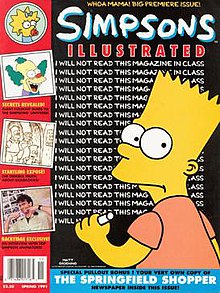Simpsons Illustrated
 Cover of the first Simpsons Illustrated magazine | |
| Magazine editor | Ted Brock |
|---|---|
| Frequency | Quarterly |
| Circulation | 1 million |
| Publisher | Welsh Publishing Company |
| First issue | April 4, 1991 |
| Final issue Number | 1993 10 |
| Language | English |
Simpsons Illustrated was a companion magazine to the American
History
Simpsons Illustrated was produced by Matt Groening, Bill Morrison, Cindy and Steve Vance,[3] and Katy Dobbs was the editorial director.[1] It ran for ten issues from 1991 to 1993. Welsh Publishing Company issued it four times a year.[4][5] The magazine had a circulation of one million.[6]
Bill Morrison drew and wrote all the Simpsons comics for Simpsons Illustrated,[7] while the Arnold strip was drawn by Simpsons creator Matt Groening's brother-in-law, Craig Bartlett. This strip was later adapted for the animated series Hey Arnold!.[8]
The first issue was released on April 4, 1991. It included a copy of the Springfield Shopper, a fictional newspaper from the show, and a fold-out poster describing every character from the show and their relationship to each other. An original bedtime story told by Bart was included, along with an Official Simpsons Illustrated School Survival Handbook, which shared Bart's classroom tactical tips, guerrilla strategies and a diagram displaying the best seat in class.[4]
The final issue of Simpsons Illustrated was a one-shot comic edition titled
Content
Features in the magazine included in-depth articles and interviews with the cast and crew, diagrams of major characters' dream houses, comics, and
The magazine also reported on real news related to the show. One story was about a protest held on February 13, 1991. A local citizens' group fought the state's plan to create a nuclear waste dump in their neighborhood. It organized Citizens Against Radioactive Dumping (CARD) and demonstrated at the monthly meeting of the Low-Level Radioactive Waste Siting Commission in
See also
References
- ^ a b Meyers, Kate (March 29, 1991). "The Groening of America". Entertainment Weekly. Retrieved March 2, 2009.
- ^ Bruce Gomes. "The Simpsons Illustrated Guid". The Simpsons Archive. Retrieved December 25, 2015.
- ^ Shutt, Craig. "Sundays with the Simpsons". MSNBC. Archived from the original on July 8, 2007. Retrieved March 2, 2009.
- ^ a b c Horton, Liz (May 1, 1991). "The Simpsons turns to print". Folio: The Magazine for Magazine Management. Retrieved March 2, 2009.
- ISBN 978-0-313-28631-5. Retrieved May 18, 2020.
- ^ a b Fine, Thomas (January 12, 1992). "Cartoon heroes animate protest - Simpson look-alikes featured in fanzine feature". Syracuse Herald American (NY). p. C1.
- ^ Bullock, Lorinda (December 9, 2004). "Woo hoo! Simpsons on display in downriver Wyandotte". Detroit Free Press. p. 8.
- ^ a b Joe K. Bevilacqua, Joe K. (December 1998). "Craig Bartlett's Charmed Past Life". Animation World Network. Retrieved March 2, 2009.
- ^ Radford, Bill (November 19, 2000). "Groening launches Futurama comics". The Gazette. Retrieved March 2, 2009.
